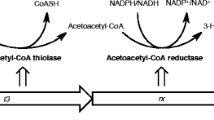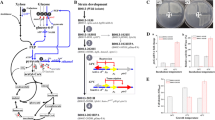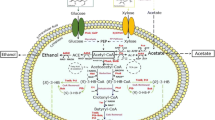Abstract
Efficient utilization of the pentosan fraction of hemicellulose from lignocellulosic feedstocks offers an opportunity to increase the yield and to reduce the cost of producing fuel ethanol. The patented, genetically engineered, ethanologenEscherichia coli B (pLOI297) exhibits high-performance characteristics with respect to both yield and productivity in xylose-rich lab media. In addition to producing monomer sugar residues, thermochemical processing of biomass is known to produce substances that are inhibitory to both yeast and bacteria. During prehydrolysis, acetic acid is formed as a consequence of the deacetylation of the acetylated pentosan. Our investigations have shown that the acetic acid content of hemicellulose hydrolysates from a variety of biomass/waste materials was in the range 2–10 g/L (33–166 mM). Increasing the reducing sugar concentration by evaporation did not alter the acetic acid concentration. Acetic acid toxicity is pH dependent. By virtue of its ability to traverse the cell membrane freely, the undissociated (protonated) form of acetic acid (HAc) acts as a membrane protonophore and causes its inhibitory effect by bringing about the acidification of the cytoplasm. With recombinantE. coli B, the pH range for optimal growth with glucose and xylose was 6.4–6.8. With glucose, the pH optimum for ethanol yield and volumetric productivity was 6.5, and for xylose it was 6.0 and 6.5, respectively. However, the decrease in growth and fermentation efficiency at pH 7 is not significant. At pH 7, only 0.56% of acetic acid is undissociated, and at 10 g/L, neither the ethanol yield nor the maximum volumetric productivity, with glucose or xylose, is significantly decreased. The “uncoupling” effect of HAc is more pronounced with xylose and the potency of HAc is potentiated in a minimal salts medium. Controlling the pH at 7 provided an effective means of circumventing acetic acid toxicity without significant loss in fermentation performance of the recombinant biocatalyst.
Similar content being viewed by others
References
Wright, J. D. (1988),Chem. Eng. Progress 84, 62–68.
Wyman, C. E. and Hinman, N. D. (1990),Appl. Biochem. Biotechnol. 24/25, 735–753.
Bull, S. R. (1990),Energy from Biomass & Wastes XIV, Klass, D. L., ed., Institute of Gas Technology, Chicago, IL, pp. 1–14.
Lynd, L. R. (1990),Appl. Biochem. Biotechnol 24/25, 695–719.
Lynd, L. R., Cushman, J. H., Nicholas, R. J., and Wyman, C. E. (1991),Science 251, 1318–1323.
Grethlein, H. E. (1985),Bio/Technology 3, 155–160.
Grohmann, K., Himmel, M., Rivard, C., Tucker, M., Baker, J., Torget, R., and Graboski, M. (1984),Biotech. Bioeng. Symp. 14, 139–157.
Kong, F., Engler, C. R., and Soltes, E. (1992),Appl. Biochem. Biotechnol. 34/35, 23–35.
Grethlein, H. E., Allen, D. C., and Converse, A. O. (1984),Biotech. Bioeng. 26, 1498–1505.
Grohmann, K., Torget, R., and Himmel, M. (1986),Biotechnol. Bioeng. Symp. 17, 135–151.
Torget, R., Werdene, P., Himmel, M., and Grohmann, K. (1990),Appl. Biochem. Biotechnol. 24/25, 115–126.
Torget, R., Walter, P., Himmel, M., and Grohmann, K. (1991),Appl. Biochem. Biotechnol. 28/29, 75–86.
Stanek, D. A. (1958),Tappi J. 41, 601–609.
Beck, M. J. (1986),Biotechnol. Bioeng. Symp. 17, 617–627.
Fein, J. E., Tallim, S. R., and Lawford, G. R. (1984),Can. J. Microbiol. 30, 682–690.
Frazer, F. R. and McCaskey, T. A. (1989),Biomass 18, 31–42.
Nishikawa, N. K., Sutcliffe, R., and Saddler, J. N. (1988),Appl. Microbiol. Biotechnol. 27, 549–552.
Ando, S., Arai, I., Kiyoto, K., and Hanai, S. (1986),J. Ferment. Technol. 64, 567–570.
Jefferies, T. W. (1981),Biotechnol. Bioeng. Symp. 11, 315–324.
Lynd, L. R. (1989),Adv. Biochem. Eng. Biotechnol. 38, 1–52.
Skoog, K. and Hahn-Hägerdal, B. (1988),Enzyme Microbiol. Technol. 10, 66–88.
Prior, B. A., Kilian, S. G., and du Preez, J. C. (1989),Process Biochemistry 24, 21–32.
Timell, T. E. (1967),Wood Science and Technology 1, 45–70.
Tran, A. V. and Chambers, R. P. (1986),Enzyme Microbiol. Technol. 8, 439–444.
Parekh, S. R., Parekh, R. S., and Wayman, M. (1987),Process Biochemistry 22, 85–91.
du Preez, J. C., Bosch, M. and Prior, B. A. (1986),Enzyme Microb. Technol. 8, 360–364.
Lee, Y. Y. and McCaskey, T. A. (1983),Tappi J. 66, 102–107.
van Zyl, C., Prior, B. A., and du Preez, J. C. (1988),Appl. Biochem. Biotechnol. 17, 357–369.
Wilson, J. J., Nishikawa, N. N., Deschatelets, L., and Nguyen, Q. (1990), Vol. I and II. Final Report of DSS Contract File #051SZ.23283-8-6103. Alternative Energy Division; Energy, Mines and Resources Canada, Ottawa.
Björling, T. and Lindman, B. (1989),Enzyme Microbiol. Technol. 11, 240–246.
Ingram, L. O., Alterthum, F., Ohta, K., and Beall, D. S. (1990), inDevelopments in Industrial Microbiology, Pierce, G. E., ed., vol. 31, Elsevier, New York, pp. 21–30.
Ingram, L. O., Conway, T., and Alterthum, F. (1991), United States Patent 5,000,000.
Ingram, L. O. and Conway, T. (1988),Appl. Environ. Microbiol. 54, 397–404.
Alterthum, F. and Ingram, L. O. (1989),Appl. Environ. Microbiol. 55, 1943–1948.
Ingram, L. O., (1990), inEnergy from Biomass & Wastes XIV, Klass, D. L., ed., Institute of Gas Technology, Chicago, IL, pp. 1105–1126.
Ohta, K., Alterthum, F., and Ingram, L. O. (1990),Appl. Environ. Microbiol. 56, 463–465.
Lawford, H. G. and Rousseau, J. D. (1991),Appl. Biochem. Biotechnol. 28/29, 221–236.
Lawford, H. G. and Rousseau, J. D. (1991), inEnergy from Biomass & Wastes XV, Klass, D. L., ed., Institute of Gas Technology, Chicago, IL, pp. 583–622.
Lawford, H. G. and Rousseau, J. D. (1991),Biotechnol. Letts. 13, 191–196.
Lawford, H. G. and Rousseau, J. D. (1992),Appl. Biochem. Biotechnol. 34/35, 185–204.
Lawford, H. G. and Rousseau, J. D. (1992), inEnergy from Biomass & Wastes XVI, Klass, D. L., ed., Institute of Gas Technology, Chicago, IL (in press).
Lawford, H. G. and Rousseau, J. D. (1993),Appl. Biochem. Biotechnol., this vol.
Lawford, H. G. and Rousseau, J. D. (1992),Biotechnol. Letts. 14, 421–426.
Zabriskie, D. W. and Arcuri, E. J. (1986),Enzyme Microb. Technol. 8, 706–717.
Luria, S. E. and Delbruck, M. (1943),Genetics 28, 491–511.
Nicholls, D. G. (1982),Bioenergetics—an Introduction to the Chemiosmotic Theory, Academic, Toronto, pp. 56–58.
Postma, E., Verduyn, C., Scheffers, W. A., and van Dijken, J. P. (1989),Appl. Environ. Microbiol. 55, 468–477.
Pampulha, M. E. and Louriero, V. (1989),Biotechnol. Letts. 11, 269–274.
Verduyn, C., Postma, E., Scheffers, A., and van Dijken, J. P. (1990),J. Gen. Microbiol. 136, 395–403.
Repaske, D. R. and Adler, J. (1981),J. Bacteriol. 145, 321–325.
Conway, E. J. and Downey, M. (1950),Biochem. J. 47, 347.
Mitchell, P. (1973),J. Bioenergetics 4, 63–91.
Padan, E. D., Zilberstein, D., and Schuldiner, S. (1982),Biochim. Biophys. Acta. 650, 131–156.
Booth, I. R. (1985),Microbiol. Rev. 49, 359–378.
Verduyn, C., Postma, E., Scheffers, A., and van Dijken, J. P. (1990),J. Gen. Microbiol. 136, 405–412.
Pampulha, M. E. and Loureiro-Dias, M. C. (1989),Appl. Microbiol. Biotechnol. 31, 547–550.
Padan, E., Zilberstein, D., and Schuldiner, S. (1981),Biochim. Biophys. Acta 650, 131–156.
Salmond, C. V., Kroll, R. G., and Booth, I. R. (1984),J. Gen. Microbiol. 130, 2845–2850.
Hinman, N. D., Wright, J. D., Hoagland, W., and Wyman, C. E. (1989),Appl. Biochem. Biotechnol. 20/21, 391–401.
Beall, D. S., Ohta, K., and Ingram, L. O. (1991),Biotechnol. Bioeng. 38, 296–303.
Ohta, K., Beall, D. S., Mejia, J. P., Shanmugan, K. T., and Ingram, L. O. (1991),Appl. Environ. Microbiol. 57, 893–900.
Ohta, K., Beall, D. S., Mejia, J. P., Shanmugan, K. T., and Ingram, L. O. (1991),Appl. Environ. Microbiol. 57, 2810–2815.
Barbosa, M., de F. S., Beck, M. J., Fein, J. E., Potts, D., and Ingram, L. O. (1992),Appl. Environ. Microbiol. 58, 1382–1384.
Safi, B. F., Rouleau, D., Mayer, R. C., and Desrochers, M. (1986),Biotechnol. Bioeng. 28, 944–951.
Mueller, J. C. (1970),Pulp and Paper Magazine Canada 72, 72–76.
Luli, G. W. and Strohl, W. R. (1990),Appl. Environ. Microbiol. 56, 1004–1011.
Booth, I. R. and Kroll, R. G. (1983),Biochem. Soc. Trans. 11, 70–73.
Smirnova, G. V. and Oktybr'skii, O. N. (1985),Microbiology (USSR) 54, 205–209.
Smirnova, G. V. and Oktyabr'skii, O. N. (1988),Microbiology (USSR) 57, 446–451.
Author information
Authors and Affiliations
Rights and permissions
About this article
Cite this article
Lawford, H.G., Rousseau, J.D. Effects of pH and acetic acid on glucose and xylose metabolism by a genetically engineered ethanologenicEscherichia coli . Appl Biochem Biotechnol 39, 301–322 (1993). https://doi.org/10.1007/BF02918999
Issue Date:
DOI: https://doi.org/10.1007/BF02918999




